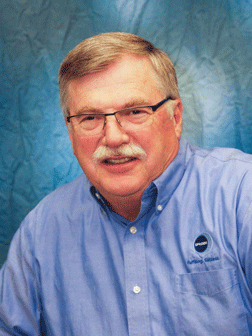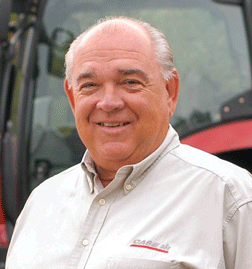The ag economy is cyclical, as everyone knows, and operating a dealership through the trough period of the cycle isn’t a new challenge. But for the younger generation of dealer management, it’s not a challenge they’ve faced until now.
Some lessons have been learned from the past, but there are still some critical mistakes being made in dealerships today.
When times are good, it’s easy to fall into bad habits. When times are tough, we often are forced into good habits, says Dan Westegaard, a consultant with Spader Business Management’s Professional Services Group. “In the farm equipment industry we had such a high period of success for a 5-10 year run — up until the fourth quarter of 2014, when we really saw a sales decline. And dealers got sloppy during that time. There are good habits we need to maintain through the ups and down, and that’s going to be the difference for a lot of dealers’ survival,” he says.
To uncover the challenges — and missteps — dealers face that can lead them down a path to failure, Farm Equipment spoke with consultants and industry veterans to learn more about the red flags to look out for and what steps dealers can take to help turn a business around. Regardless of whether a dealership has one store or 20, all are susceptible to these challenges.
More often than not, the problems that cause dealers to suffer are “little” ones that compound. “If they’ve done anything stupid on the big issues, they’d probably already be out of business,” says Stan Jackson of Jackson Consulting. “In today’s world, as competitive as it is, nobody can survive a big-issue mistake.”
Some of the struggles of the 1980s are once again hitting dealers today, says Charlie Gause, retired vice president of marketing for John Deere. “Let’s go back to the ’80s, which was a period of time that was similar in terms of equipment demand, but the economy at the time was more devastating,” he says. “The industry probably lost 50% of its dealers. We’d come through a period of high demand in the ’70s, but in the ’80s sales of new equipment fell drastically. The dealers who failed back then were the dealers who had always depended on selling new equipment. They thought the way you get out of trouble is to sell more equipment. And that isn’t the way you got out of trouble. At that time, you were generating more used equipment and you were tying up more dollars in inventory.”
Mismanaging Used Equipment
Today, managing used equipment inventories continues to be one of the biggest challenges facing dealers of all sizes. Jim Irwin, retired vice president of North American Business for Case IH, says when a dealer is struggling the root cause can usually be traced back to used equipment.
“Net profit does not pay bills, cash pays bills…” — Stan Jackson
Irwin cites an example of a multi-store dealer who was on the verge of failing. “I personally met with the dealer and I said, ‘Well, what do think you need to do?’ He said, ‘We’ve got to cut some expenses here. We probably need to close a store or two.’ I said, ‘What’s that going to do?’ ‘Well, it will save us some expenses.’ And I said, ‘What’s your biggest problem?’
“He told me he was just running out of cash, so I asked him where his cash was tied up. The dealer said, ‘Well, it’s in these used combines.’ So I said, ‘Well, how did you get so many used combines?’ Well, he was chasing market share to meet a program.
“I told him, ‘You don’t have an expense problem. You’ve got a used equipment problem. My advice to you is focus on that — you don’t need to close any stores. You need to have as many touchpoints with customers as you can find. You need to spend 100% of your effort selling used combines.’ Well, he said, ‘I won’t make my market share numbers then.’ I told him, ‘I don’t care if you make your market share numbers. I care about you being here 2 years from now.’
“I told him I’d take the heat from the company on any market share deficiencies; it’s more important to stay in business than it is to make market share in the next 2 years.”
The dealer took Irwin’s advice. Today he is still in business and doing very well, he says.
George Russell, consultant and one of the founders of the Machinery Advisory Consortium, agrees the chase for market share can cause dealers to overextend themselves and end up in trouble with their used equipment. He cited a large multi-location dealership that went under. “They were running after market share and rolling many combines to their A-level customers. They got overextended when the rolls started backing up. The manufacturers had to shut dealers down because of lack of credit. The combine roll programs can be good business, but they can also create a vulnerable situation if you don’t execute well and don’t understand when the market is shifting, as is it is right now,” he says.
Irwin says one thing dealers often struggle with is making sure they have customers lined up to absorb the used equipment that comes in on trade. For example, if a dealer sells 10 new combines a year, he needs to have 35-40 customers lined up to absorb all the trade-ins that are going to take place while you’re washing out those 10 new combine sales, he explains.

“Managing personnel expense is really one of the key differentiators between those who are successful and those who are not...” — Dan Westegaard
“Too many of them who are new to the business don’t look at it that way. They see the glamour in selling the new and they don’t understand the whole picture,” Irwin says.
The risk associated with high used inventory is greater than it is with new equipment, Irwin adds, because of the simple fact that if the dealer goes out of business that used equipment is his. With new equipment, most dealer contracts stipulate that the manufacturer buy the inventory back.
The difference between the dealers who work their way out of a used equipment build-up and others who can’t often comes down to communicating and being honest with the customer. “What those dealers need to do is coach those customers who want to buy,” Russell says.
“They have to say, ‘I’m sorry, I can’t trade your low-hour machine right now because I’ve got too many already.’ The best dealers have that relationship with those A customers and they start extending the rolls. A 1-year roll becomes a 2-year, a 2-year becomes a 3-year, and so on.”
In a relationship-driven business, transparency and having a level of trust with your customers and being able to count on that is fundamental to success, Russell says.
Out of Balance Revenue
Dealers with excessive pride — the need to be big and visible — tend to be those who are more likely to get overextended and out of balance, Russell says. By that he means they are putting too much focus on wholegoods, particularly the new. “Then, they either get bit by the used backing up because they don’t have a balanced approach to aggressively market used and/or they aren’t working on the parts and service side of the business for absorption,” he says.
Irwin agrees that the struggling dealers fail to understand what their mix of revenues needs to be. “When you put the numbers to it, the service portion of it is usually the smallest percent of the total revenue. I like to see service at about 10% of revenue, parts about 25% of the total revenue and wholegoods about 65%. Some would say, ‘Well if wholegoods is at 65%, that’s where you ought to put your effort.’ And that’s what a lot of dealers do and that’s where they get in trouble,” says Irwin.
According to research Irwin has done going back to 1982, wholegoods margins have been in the range of 6.11%-8.54% over the last 30 years, with the average being 7.3%. “That’s not a lot of margin, but that’s what it is. The market, not the individual dealers, determines margin,” he says.
Westegaard concurs. “A few years ago some dealers had 85% or more of their total company sales coming from wholegoods because the wholegoods area grew so fast. That wasn’t healthy. They were kind of like drunken sailors,” he says.
“When they were selling all of that big new equipment 3 or 4 years ago, some knew in their gut they were selling too much new equipment and they wouldn’t be able to handle all the used, but they just couldn’t help themselves.”

“The biggest mistake dealers make is managing to impress their majors. They’re managing their sales to maximize market share to stay off the ‘manufacturer’s blacklist’…” — Stan Jackson
Right now the market is helping dealers adjust their sales mix, Westegaard says, because wholegoods sales are down 20-40% year-over-year for the last 2 years. He notes that wholegoods sales for one dealer he is working with are down by nearly half from 2 years ago.
“While the market is helping correct that, in the meantime dealers need to focus on their parts and service departments to make sure that they’re performing at a high level. They need to be focused on their margins in the parts and service departments. They’ve got to make sure they maximize their margins,” he says.
The industry as a whole has not been particularly good at marketing the aftermarket business, but it’s essential to improving the sales mix that’s needed. “We’ve been such a strong service provider, our customers come to us when they’re broke down, they need parts, they need service,” Westegaard says.
“But we’ve never turned that corner as far as truly making our parts and service departments more sales driven. A lot of people are struggling with how to do a better job of marketing parts and service and making sure their parts and service managers are more sales oriented.”
So, what does a dealer need to do to get the sales mix back in balance? One option is to reduce their wholegoods business, which would get the sales mix back in shape and eventually will take care of some cashflow problems. The other option, and that which Irwin prefers, is to look for ways to increase your product support mix in parts and service.
“Back in the day, we would figure that a combine would generate $100,000 in parts sales over its useful life,” he says. “You should be able to sell $1 worth of labor for every $1 worth of parts. So if you’ve got $100,000 worth of parts sales at 30% margin, that’s $30,000.
“But if you’ve got a $100,000 worth of labor at 60%, that’s $60,000. You can generate a huge amount of margin from product support over the lifetime of one combine. The margin from parts and service over 20 years would probably be 6-7 times the margin that dealers made off the piece when they sold it new. It’s a balancing act that you have to do. And it’s not a one or the other; it’s a three-legged stool, so to speak. Every one of them has to be in balance.”
Avoiding Cashflow Problems
Another mistake that dealers are guilty of is not distinguishing between Earnings Before Interest, Taxes, Depreciation and Amortization (EBITDA) and net profit, according to Jackson.
“That’s happening a lot today because so much of the net profit is tied up in used equipment so their net profit line looks good. However, if you go out and appraise and actually put a quantitative number to that used equipment, their net profit would suffer dramatically,” he says.
“I encourage dealers to pay less attention to net profit as they do to the EBITDA numbers because EBITDA is a good proxy for cashflow.”
As Jackson puts it, EBITDA is a “non-lying kind of number. It tells you if you’re generating enough cash to stay in business. It is entirely different from net profit.” He says EBITDA is the number dealers need to be checking on a weekly basis.
Unfortunately, many struggling dealers are not monitoring it.
“Dealers need to set on the back burner the idea that net profit is the king. In today’s world, cash is the king and the only ongoing way you can measure cash in a dealership is to be very conscious of the EBITDA outcome. This is old stuff, but stuff that needs to be repeated,” Jackson says.
He adds that dealers are becoming increasingly more aware of the distinction between cash and net profit. But traditionally when dealers are in peer groups where they want to “impress” other dealers, it’s net profit they talk about.
“It’s a cultural thing, and it can be difficult to change to a culture where cashflow is examined as a management tool,” he says.
Capital goods expense, depreciation and inflated assets might not always show up in net profit, but they impact cashflow. These issues usually come back to used equipment. “If you have a lot of equipment out there that’s on the books for $2 million and it’s worth $1 million; obviously you’ve overstated your net profit by $1 million. EBITDA numbers will show the reality of the situation more quickly,” Jackson explains.

“Wholegoods margins have been in the range of 6.11%-8.54% over the last 30 years, with the average being 7.3%. That’s not a lot of margin, but that’s what it is. The market, not the individual dealers, determine margin…” — Jim Irwin
He says dealers often manage sales to impress their major line suppliers — to maximize market share — and thus staying off the manufacturers’ “blacklist” to avoid the dreaded performance letter, a red flag that the dealer is in trouble. “That letter says something along the lines of ‘You’ve got X amount of time to clear up this deficiency or we’ll need to talk about you leaving the industry or at least become a target for takeover,’” Jackson says.
Managing the business this way is a slippery slope. Jackson explains: “Dealers are running their business to keep their market share up, which means they’ve got to poach from other dealers. To do that, they overallow for used. That overallowance shows up in used equipment values and the used equipment values shows up in cashflow deficiency and cashflow deficiency shows up in struggling to pay the bills.”
Dealers need to establish where the acceptable market share line is for their OEM, while also satisfying the dealer’s need for cash, Jackson says. “You need to find that line and then walk that line all the time. And that will help dealers stay out of the ‘performance letter’ category.”
To maximize cashflow, Jackson says dealers not only need to grow by acquisition but also grow internally. “That’s why we do the SWOT analysis of each and every department and each and every person, to see if every person in every department and every input to that dealership is being maximized to contribute to cashflow,” he says.
Slow to React
When it comes time to make tough decisions, Westegaard says dealers who are in jeopardy are generally slow to react. “Maybe they need to cut expenses or maybe they need to cut personnel, but they hesitate to do it, and that can get them into trouble,” he says.
While eliminating some positions might be necessary, Westegaard acknowledges it’s not an easy decision. “They’re still small businesses. They have family and friends working for them and cutting employees and expenses is really hard to do. They hesitate to do it, even though they know they should,” he says.
For example, Westegaard says a lot of his 20 group members tell him they don’t want to lay off any of their people. Instead they’re cutting back hours and doing everything they can to avoid layoffs.
“In their heart, they don’t want to lay off any people and some had to because in the last couple years, personnel expense, which is always the largest single expense of the dealership, has gotten out of hand,” he says.
While dealers can reduce personnel expense dollars through attrition, Westegaard says their expense ratios (expense as a percent of gross margin dollars) still go up because sales and available income or sales and gross margin dollars are dropping at a faster rate. It can be tough to make those decisions, but they need to be made to ensure a basic level of profitability, he says.
“Managing personnel expense is one of the key differentiators between those who are successful and those who are not.”
Neglecting the Business
The reason a dealership might fail can also be more behavioral, such as neglecting the business and its employees. Jackson has a very simple test to see if the boss has been neglectful. “Go into a dealership and ask the employees in the parts and service departments when they last saw their boss, or when was the last time this store manager said hello to you. We also go to the boss and say, ‘When was the last time you said hello to John Smith out in the parts or service department?’ Then we compare the answers,” he says.
Without fail, the manager always believes he’s spoken to the employees far more than what employees say, Jackson says. “In other words, the owner thinks he’s doing it 100% more than the employee thinks.” And while there may be some selective memory on both sides, Jackson says this can be a good indication of how involved the manager is with his employees.
Sometimes a small mistake indicates larger problems looming elsewhere. An example is out of date pricing on merchandise or only changing up the merchandising layout during the holiday season. These may seem like small mistakes, but Jackson says it indicates other areas of neglect. “If prices on the merchandise are being neglected, then there are bigger things, too,” he says.
The biggest red flag of neglecting the business, according to Jackson, is a manager who doesn’t have a go-to person at the store who can act on his behalf on operational issues while he’s gone. And, it needs to be more than just someone who the boss gives a nod to and says, “OK, you’re in charge.” The individual needs to be given the responsibility — more importantly needs to have been mentored — and has the authority and knowledge to run things in the boss’ absence. “If the boss is gone a lot and doesn’t have somebody who can fill his shoes, that’s a serious sign,” he says.
For dealerships with multiple locations, dealer-principals must have the right people in place to run those satellite locations, Gause says.

“The sign of a good dealership is leaders/managers who are broad enough to attend to that vital part of any business. The sign of a poor performing dealership is when the human resource development is lacking…” — George Russell
“They need to be able to rely on those people to help them. They’ve got to delegate responsibility and demand that the person does the right job and recruits for the right kind of people. We only have three things we had to deal with in our business — people, product and profit,” he says.
To dealers who say they just can’t find good people, Gause has a simple answer. “What I reply with is they aren’t looking hard enough and they’ve got to raise their sights higher. Go to a college and recruit and hire the right people.”
No Plan for the Future
In a similar vein, Russell says a big error made by many dealers who ultimately go out of business is not having a succession plan. “Many dealers go out of business completely either because they don’t have a succession plan or they aren’t attractive to another buyer, which is a problem in this period of consolidation. And that in essence is a failure,” he says.
From a manufacturer’s standpoint, the majors want their dealers to have a succession plan because it keeps their brand represented in an area. “They don’t want to leave an area dark,” Russell says. “They want to have some idea of what’s going to happen in the dealer’s succession.”
Good leaders train their successor. “That’s a problem in our business that has come up with individual entrepreneur founders or multi-generation owner families. Sometimes there is no next generation or the next generation has neither the capability nor the interest to run the dealership well,” Russell says.
When that’s the case, it’s imperative for dealers to look outside the family, and perhaps even outside the dealership, to find and prepare a successor to ensure the business’ future.
“Because the nature of this business is to solve problems daily — either with the customers or within the dealerships — sometimes we miss the management development, the succession, the coaching; the people side of the business,” Russel says. “A sign of a good dealership is leaders/managers who are broad enough to attend to that vital part of any business. The sign of a poor performing dealership is when the human resource development is lacking.”
Plan & Communicate to Stay Successful
When a dealership establishes a plan turn the business around and get back on the path toward success, the work isn’t done. It takes continuous planning to stay on track, says Gause. “You must put together a good, strong plan and continue to communicate that. Never just be happy with where you are,” he says.
Gause says dealers need to always be working toward improvement and can’t get complacent with the status quo. “Continuous improvement, to me, is the key to doing the right thing,” he says. “For example, say you’re getting 70% market share. That’s good, right? It may be good and it may not be. What’s good is 7 out of every 10 machines sold, you’re selling. But is your margin good? Could you improve your margin on that? Is your customer satisfaction 100%? Probably not. Those are things you can continually improve. So, 70% market share may be one good thing, but if you’re losing money — say your gross margin is low — you need to continually improve on that.”
He also says it’s important for dealers to look at what they can do over a short-term period and long term. Even if 100% market share seems unrealistic, that should be your long-term goal, he says. “You don’t go to college and say, ‘Well, I think I’ll make all C’s,” Gause says.
“If you do, you’re probably going to make D’s and C’s, and that will be as well as you’ll do. But, why not shoot for an A? You can never be good enough.”
Read more below:
Turning Your Dealership Around
CASE STUDY: Bringing a Dealership Back from the Brink
Failure to Communicate Can Lead to Business Failure
January Showcase 2017 Issue Contents






